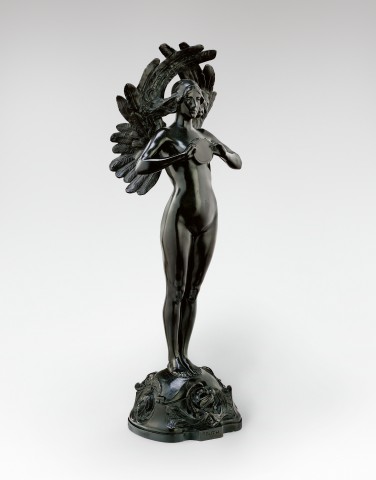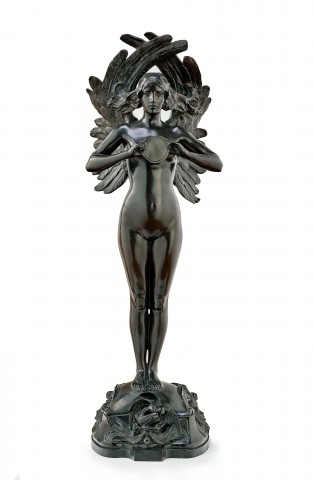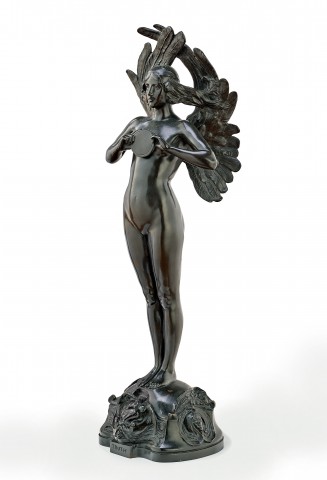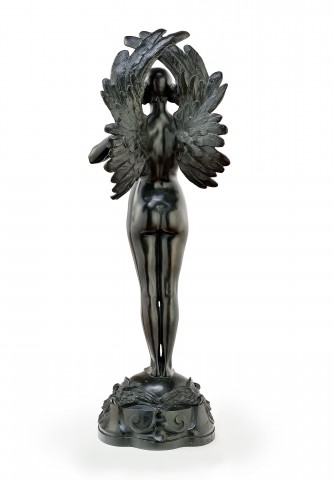TRUTH, 1894
BERTRAM MACKENNAL
bronze
61.0 cm height
signed at base: MACKENNAL
dated and inscribed with title at base: JUNE 12 - 1894 LONDON / TRUTH
Collection of the artist
Thence by descent
Pippin Drysdale, Perth
Sotheby's, Sydney, 22 April 2008, lot 57
Company collection, Melbourne
Deutscher and Hackett, Sydney, 1 September 2010, lot 26
McClelland Collection, McClelland Sculpture Park and Gallery, Langwarrin, acquired from the above through the Elisabeth Murdoch Sculpture Fund
The Royal Glasgow Institute of Fine Arts, Glasgow, Scotland, 1905, cat. 848 (another example)
The Franco-British Exhibition, London, UK, 1908, cat. 1402 (another example)
Exhibition of bronzes by Sir Bertram Mackennal K.C.V.O., R.A., Macquarie Galleries, Sydney, 7 – 20 October 1926, cat. 9 (another example)
Exhibition of Bronzes by Sir Bertram Mackennal, Fine Art Society’s Gallery, Melbourne, 16 – 29 May 1928, cat. 3 (another example)
Commemorative Exhibition of Works by Late Members, Winter Exhibition, Royal Academy of Arts, London, UK, 7 January – 11 March 1933, cat. 82 (another example)
150 Years of Australian Art, Art Gallery of New South Wales, Sydney, 27 January – 25 April 1938, cat. 168 (another example)
Early Australian Sculpture: From its Beginnings up to circa 1920, Ballarat Fine Art Gallery, Victoria, December 1976 – 15 March 1977, cat. 29 (another example)
Australian Sculpture 1890 – 1919, Art Gallery of New South Wales, Sydney, 22 January – 22 February 1987 (another example)
Australian icons: twenty artists from the collection, Art Gallery of New South Wales, Sydney, 4 August – 3 December 2000 (another example)
Bertram Mackennal: The Fifth Balnaves Sculpture Project, Art Gallery of New South Wales, Sydney, 17 August – 4 November 2007; and touring to National Gallery of Victoria, Melbourne, 30 November 2007 – 24 February 2008 (another example)
Art in Australia, Series 3, no. 57, 15 November 1934, p. 44 (illus., another example)
Australasian Antique Collector, no. 20, 1980, cover (illus., another example)
Tranter, R. R., Bertram Mackennal: A Career, Parker Pattinson Publishing, New South Wales, 2004, cat. 27, pp. 43 – 44, 53, 100, 125
Edwards, D., et al., Bertram Mackennal, Art Gallery of New South Wales, Sydney, 2007, pp. 2 (illus., detail), 36, 37 (illus., another example), 47, and catalogued in accompanying CD-ROM
Other examples of this work are held in the collections of the Art Gallery of New South Wales, Sydney, the National Gallery of Australia, Canberra, the Art Gallery of South Australia, Adelaide and the Queensland Art Gallery | Gallery of Modern Art, Brisbane
Lot 5 Mackennal, Truth.jpg
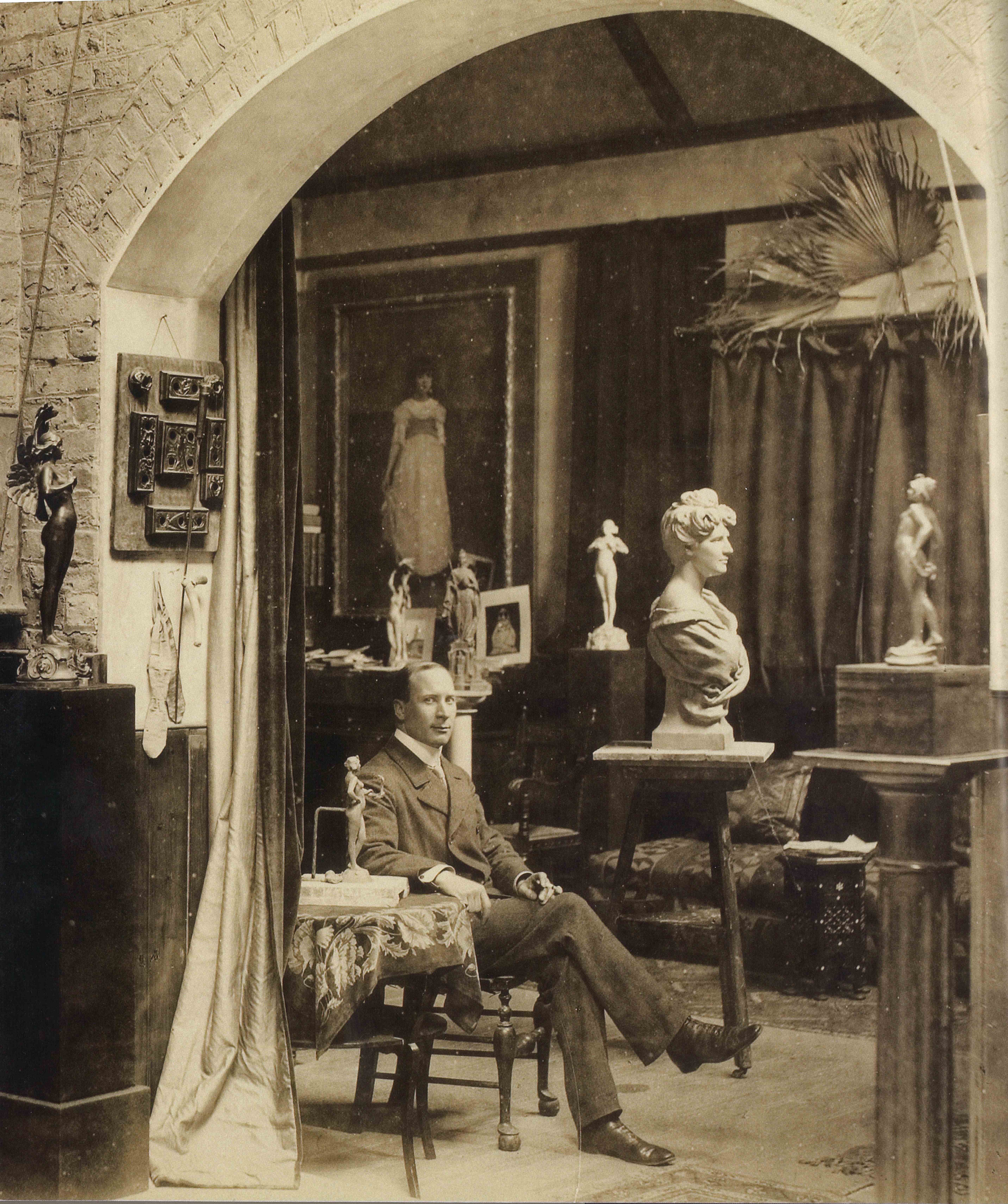
|
Bertram Mackennal in his London studio, c.1898. Courtesy: Pauline Kraay
|
‘Truth holds her mirror outwards on her breast for the entire world to see what may be reflected there. The little statuette is very finely finished and has been rightly and abundantly admired.’1
Widely acclaimed among the masterpieces of Mackennal’s oeuvre such as Circe (lot 4), Daphne, Victory and Salome (lot 6), Truth, 1894 eloquently encapsulates the Australian sculptor’s fluency in the radical style of late nineteenth-century British ‘New Sculpture’ with its Symbolist, Art Nouveau and Classicist tendencies and abiding interest in allegorical female imagery. Continuing a literary tradition that had long personified Truth as a naked woman, thus Mackennal here gives sculptural form to the idiomatic expression ‘naked truth’, thematising the attribute as a psychological act. As Deborah Hart elaborates, ‘…the figure’s nakedness [is] a metaphor for ‘unclothed’ truth, the tautness of her body carrying resonances of Circe’s force and sternness, her face frank, fearless and earnest, and her wings indicative of a being with the moral authority of a higher realm. Like Circe, her gesture extends to the imagined viewer. Truth holds up a burnished disc which reflects a reality incapable of compromise…’2 Furthermore, with its self-conscious connection to Circe, and its burnished surfaces and idealised naturalism evoking the then well-established neo-Florentine tendencies of British sculpture, Truth powerfully demonstrated those means – poetic, allegorical, decorative, classicist – by which Mackennal would ultimately rise to the uppermost ranks of early twentieth-century sculptors.3
Significantly, such embodiment of truth and its application in real life held particular resonance for Mackennal during these years, and it is not fanciful to suggest that the statuette was created by the young artist as a rebuke to the art establishments of Melbourne and London. Indeed, three years prior in 1891 while Mackennal was in Melbourne after studies in Paris and London, he had famously entered his Triumph of Truth, 1891 – a monumental achievement in the French Beaux-Arts style – into a competition for a major sculpture to adorn the front of the National Gallery of Victoria. To Mackennal’s great disappointment, his entry received only the faint praise of a second prize with no first being awarded as the Trustees considered that none of the designs proffered were worthy of the commission. The public outcry was loud, with many (including the famed French actress Sarah Bernhardt who was touring Melbourne at the time) considering the verdict both an insult to Mackennal and an indication of how poorly European avant-garde art was understood in Australia.4 Encouraging him to seek acceptance in a more international, cosmopolitan market, thus Bernhardt and a group of wealthy Melbourne patrons provided financial support for Mackennal to return to Paris where he did finally receive that elusive recognition. In 1892, two sculptures were accepted into the Paris Salon, and in 1893, his life-sized, Symbolist-inspired Circe received an esteemed mention honorable from the Salon Jury. The following year, his seductive sorceress was accepted for the summer exhibition of the Royal Academy of Arts, London, making him the first Australian artist to exhibit there – although the overt sexuality of the pedestal frieze depicting tumbling orgiastic nudes was too much for the prudish sensibilities of the hanging committee and the work was accordingly placed on display with the base covered. Not surprisingly, both the quality of the work and the cause célèbre of its censorship guaranteed the young artist notoriety, and his career was launched.
Modelled in London in 1894 and cast in bronze in Paris around 1897 – 98, Truth was notably conceived and first editioned as a token of appreciation for those wealthy Melburnians who had generously initiated a trust fund to enable Mackennal and his family to live and work in Paris from 1892 onwards. Perhaps not coincidentally, the sculpture echoed the subject of his original, failed entry for the National Gallery of Victoria commission – with the choice of truth no doubt a veiled allusion to the ‘rightness’ of both Mackennal’s art and those far-sighted patrons. Notably, when one such supporter, Mr Frank Stuart, clothing manufacturer, land speculator and politician, subsequently displayed Truth in the window of Allen’s music shop in Collins Street, Melbourne in October 1897, it represented the first mature example of Mackennal’s sculpture to be seen by ordinary Melburnians who could not afford to travel abroad to Britain and the continent. Art critics were unanimously ecstatic about not only the sculptor’s unparalleled talent, but the charisma and presence of the statuette itself, celebrating the work as a touchstone to the exceptional career that was unfolding half a world away.5 ‘The expression on the face is frank, fearless and earnest, and the pose carries the same idea, heightened perhaps by an indefinable suggestion of sternness, even defiance. That the modelling is faultless need scarcely be said… around the base are mythological heads, beautifully executed, and every detail is worked out perfectly.’6
Without doubt, Mackennal had a special fondness for Truth, featuring casts in a number of prominent exhibitions at all stages of his career including his solo exhibition at the National Gallery of Victoria in 1901; the groundbreaking First Exhibition of statuettes by sculptors of Today, English and French sculpture for the home at the Fine Arts Society, London in 1902; the Royal Glasgow Institute of Fine Arts and the Royal Scottish Academy exhibition in Edinburgh in 1925; and the sell-out Macquarie Galleries exhibition in Sydney in 1926. Poignantly, Truth also appeared in the two memorial exhibitions for Mackennal upon his death – namely, a commercial show at the London Fine Arts Society, and the loan exhibition at the Royal Academy.7
1. The Sun, Melbourne, 29 October 1897, p. 13
2. Edwards, D., Bertram Mackennal, Art Gallery of New South Wales, Sydney, 2007, p. 37
3. ibid.
4. See Peers, J., catalogue entry for lot 81, in Bonhams, Important Australian Art From the Collection of Reg Grundy AC OBE and Joy Chambers-Grundy, Sydney, 26 June 2013
5. ibid.
6. Table Talk, Melbourne, 29 October 1897, p. 4
7. Peers, op. cit.
VERONICA ANGELATOS
